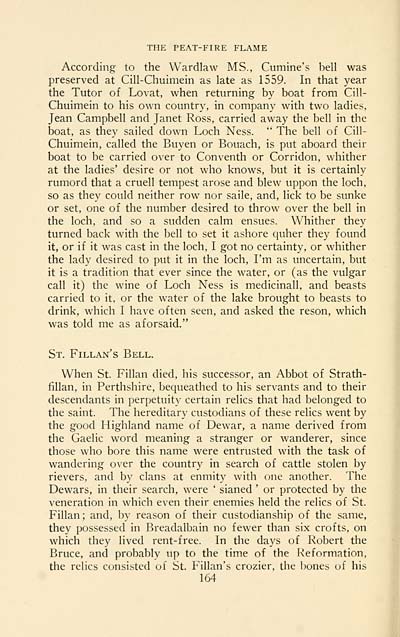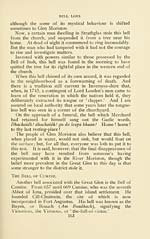Ossian Collection > Peat-fire flame
(208)
Download files
Complete book:
Individual page:
Thumbnail gallery: Grid view | List view

THE PEAT-FIRE FLAME
According- to the Wardlaw MS., Cumine's bell was
preserved at Cill-Chuimein as late as 1559. In that year
the Tutor of Lovat, when returning by boat from Cill-
Chuimein to his own country, in company with two ladies,
Jean Campbell and Janet Ross, carried away the bell in the
boat, as they sailed down Loch Ness. " The bell of Cill-
Chuimein, called the Buyen or Bouach, is put aboard their
boat to be carried over to Conventh or Corridon, whither
at the ladies' desire or not who knows, but it is certainly
rumord that a cruell tempest arose and blew uppon the loch,
so as they could neither row nor saile, and, lick to be sunke
or set, one of the number desired to throw over the bell in
the loch, and so a sudden calm ensues. Whither they
turned back with the bell to set it ashore quher they found
it, or if it was cast in the loch, I got no certainty, or whither
the lady desired to put it in the loch, I'm as uncertain, but
it is a tradition that ever since the water, or (as the vulgar
call it) the wine of Loch Ness is medicinall, and beasts
carried to it, or the water of the lake brought to beasts to
drink, which I have often seen, and asked the reson, which
was told me as aforsaid."
St. Fillan's Bell.
When St. Lilian died, his successor, an Abbot of Strath-
fillan, in Perthshire, bequeathed to his servants and to their
descendants in perpetuity certain relics that had belonged to
the saint. The hereditary custodians of these relics went by
the good Highland name of Dewar, a name derived from
the Gaelic word meaning a stranger or wanderer, since
those who bore this name were entrusted with the task of
wandering over the country in search of cattle stolen by
rievers, and by clans at enmity with one another. The
Dewars, in their search, were ' sianed ' or protected by the
veneration in which even their enemies held the relics of St.
Lilian ; and, by reason of their custodianship of the same,
they possessed in Breadalbain no fewer than six crofts, on
which they lived rent-free. In the days of Robert the
Bruce, and probably up to the time of the Reformation,
the relics consisted of St. Lilian's crozier, the bones of his
164
According- to the Wardlaw MS., Cumine's bell was
preserved at Cill-Chuimein as late as 1559. In that year
the Tutor of Lovat, when returning by boat from Cill-
Chuimein to his own country, in company with two ladies,
Jean Campbell and Janet Ross, carried away the bell in the
boat, as they sailed down Loch Ness. " The bell of Cill-
Chuimein, called the Buyen or Bouach, is put aboard their
boat to be carried over to Conventh or Corridon, whither
at the ladies' desire or not who knows, but it is certainly
rumord that a cruell tempest arose and blew uppon the loch,
so as they could neither row nor saile, and, lick to be sunke
or set, one of the number desired to throw over the bell in
the loch, and so a sudden calm ensues. Whither they
turned back with the bell to set it ashore quher they found
it, or if it was cast in the loch, I got no certainty, or whither
the lady desired to put it in the loch, I'm as uncertain, but
it is a tradition that ever since the water, or (as the vulgar
call it) the wine of Loch Ness is medicinall, and beasts
carried to it, or the water of the lake brought to beasts to
drink, which I have often seen, and asked the reson, which
was told me as aforsaid."
St. Fillan's Bell.
When St. Lilian died, his successor, an Abbot of Strath-
fillan, in Perthshire, bequeathed to his servants and to their
descendants in perpetuity certain relics that had belonged to
the saint. The hereditary custodians of these relics went by
the good Highland name of Dewar, a name derived from
the Gaelic word meaning a stranger or wanderer, since
those who bore this name were entrusted with the task of
wandering over the country in search of cattle stolen by
rievers, and by clans at enmity with one another. The
Dewars, in their search, were ' sianed ' or protected by the
veneration in which even their enemies held the relics of St.
Lilian ; and, by reason of their custodianship of the same,
they possessed in Breadalbain no fewer than six crofts, on
which they lived rent-free. In the days of Robert the
Bruce, and probably up to the time of the Reformation,
the relics consisted of St. Lilian's crozier, the bones of his
164
Set display mode to: Large image | Transcription
Images and transcriptions on this page, including medium image downloads, may be used under the Creative Commons Attribution 4.0 International Licence unless otherwise stated. ![]()
| Early Gaelic Book Collections > Ossian Collection > Peat-fire flame > (208) |
|---|
| Permanent URL | https://digital.nls.uk/81148555 |
|---|
| Description | Selected books from the Ossian Collection of 327 volumes, originally assembled by J. Norman Methven of Perth. Different editions and translations of James MacPherson's epic poem 'Ossian', some with a map of the 'Kingdom of Connor'. Also secondary material relating to Ossianic poetry and the Ossian controversy. |
|---|
| Description | Selected items from five 'Special and Named Printed Collections'. Includes books in Gaelic and other Celtic languages, works about the Gaels, their languages, literature, culture and history. |
|---|

